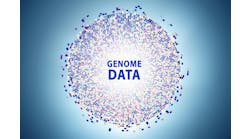With more patients being tested—and more providers ordering these tests—it’s critical for health system leaders to evaluate the workflows and solutions available to govern ordering practices and manage resulting genetic/genomic information.
Those who anticipate that their electronic medical record (EMR) will provide the flexibility necessary to accommodate the influx of genetic and genomic information will find themselves poorly prepared. Challenges will arise in three areas:
1. Core EMR functionality. These IT systems were designed to store and display “point-in-time” data, including clinical summaries, operative notes, lab tests and imaging studies. Typically, exams, workups and tests need to be repeated to reflect the patient’s current phenotypical status. Conversely, patient genetic profiles are static and can be leveraged over an individual’s lifetime. This requires IT solutions that store, manage and serve up insights derived from genetic testing across multiple providers, diverse clinical specialties and varied care settings along an extended timeline.
In addition, these solutions must also be able to integrate scientific discovery. Research around genetics and genomics is advancing at an unprecedented pace. Updates about new knowledge need to be incorporated at the point of care and within the clinical workflow so providers can combine this dynamic information with the static genetic profile
To fully optimize the power of precision medicine, healthcare leaders must explore platforms delivering informatics functionality beyond scope of current EMR software.
2 Organization-wide IT infrastructure. Healthcare has never adequately solved its interoperability problem, and the influx of precision medicine data will only exacerbate the issue. Because genetic information represents a patient’s lifetime signature, access and utilization across the enterprise (and beyond) will be critical.
The industry is currently dominated by two primary EMR vendors. The remainder of the healthcare market – half or more of provider organizations – use one of any number of smaller systems. Within many organizations, like UH Cleveland, different EMRs are used in disparate and specialty care settings (e.g., oncology, ED, LIS, etc.). Yet none of these solutions exchanges information in a satisfactory manner.
Under this scenario, a provider orders a genetic or genomic test, sending it to one of several labs that offer processing and analysis for the specific markers in question. Results are returned as non-discrete data (limiting utility of the information) as a PDF or text file, or locked behind the lab’s proprietary portal.
Beyond significantly constraining the clinical value the organization can derive from genetic and genomic test results, the lack of an adequate infrastructure impedes leadership’s ability to manage lab relationships and contracts, govern ordering processes, streamline precision medicine workflows, and prevent costly duplicative testing
3. Lagging data literacy. For the most part, clinicians received only limited education about genetics and genomics during medical or nursing training. Those with keen interest subsequently might decide, independently, to read journal articles so they can remain abreast. Unfortunately, these unstructured approaches produce great variability in terms of the how well precision medicine is being leveraged.
Consider this example. Providers today rely heavily upon the results of clinical trials, such as those comparing outcomes in patients treated with Drug A vs. Drug B where 75 percent of patients responded better to Drug A. Clinicians can access the results of the clinical study, but they have no idea which category better represents the patient immediately in front of them. Therefore, they are forced to fall back on a trial-and-error prescribing. Pharmacogenomic testing, conducted on trial participants and on patients seen in the clinical setting, allows a more precise assessment of which therapy will be safest and most effective for individual patients.
If clinicians are aware that an additional layer of data is available when they make therapeutic decisions, their patients’ response, outcomes and patient satisfaction will likely improve. To accomplish this, however, organizations are best served by software solutions that grant frictionless access to up-to-date knowledge bases and clinical guidelines to inform the course of treatment providers might pursue.
Overcoming precision medicine barriers
Leadership at UH Cleveland has embarked on a strategy to overcome these barriers. Central to its approach is utilization of a precision medicine platform that integrates with multiple genetic/genomic labs and sits on top of the EMRs used across the enterprise. Results from various molecular labs and information from the provider’s preferred clinical software is consumed and synthesized into a comprehensive clinical-genomic ontology. Insights are delivered directly to the provider’s EMR via an in-workflow application. Single-click links direct clinicians to important resources with current regulatory and clinical guidance to ensure informed decisions.
This infrastructure provides the data management functionality necessary to render the information meaningful and useful. Because it transcends individual EMRs, the platform enables providers across the entire University Hospitals system—e.g., oncology, maternal-fetal medicine, rare disease, behavioral health—to leverage insights that can transform care.
“We believe precision medicine represents the emerging standard across multiple specialties,” says Jeffrey Sunshine, M.D., Ph.D., chief medical information officer (CMIO) at UH Cleveland. “It’s critical that providers across our organization have access to meaningful and actionable information within their clinical workflow. This requires enterprise-spanning software that offers functionality beyond traditional EHRs.”
The aggressive advancement of precision medicine no doubt presents a challenge to organizations both large and small. Insightful and innovative leaders will focus on their precision medicine strategy and ensure clinicians have the tools they need to leverage the important data generated through genetic and genomic testing.
Maulik Purohit, M.D., is a physician executive, author, and innovator in health IT, artificial intelligence, stress, and brain injury. Dr. Purohit currently serves as the Clinical Innovation Lead and Associate Chief Medical Information Officer and staff physician for brain injury and neurorehabilitation at University Hospitals Cleveland.



